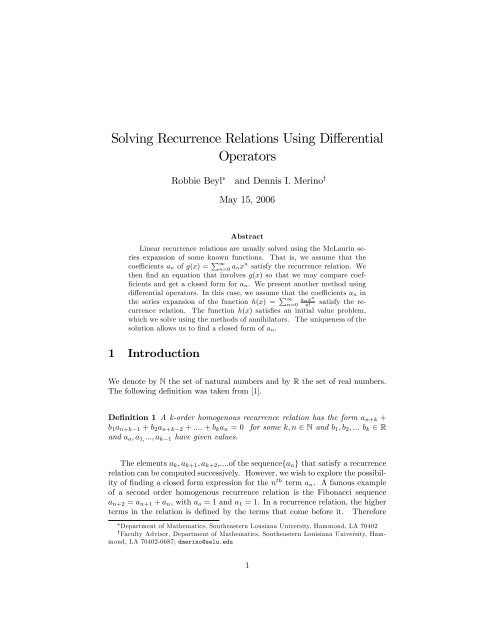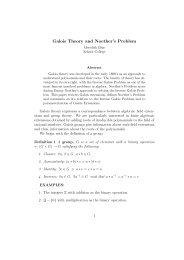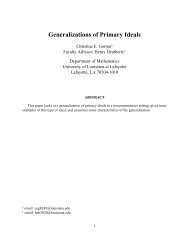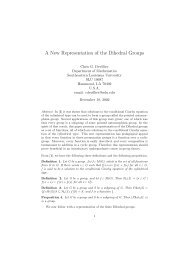Solving Recurrence Relations Using Differential Operators - Sections
Solving Recurrence Relations Using Differential Operators - Sections
Solving Recurrence Relations Using Differential Operators - Sections
Create successful ePaper yourself
Turn your PDF publications into a flip-book with our unique Google optimized e-Paper software.
<strong>Solving</strong> <strong>Recurrence</strong> <strong>Relations</strong> <strong>Using</strong> Di¤erential<br />
<strong>Operators</strong><br />
Robbie Beyl and Dennis I. Merino y<br />
May 15, 2006<br />
Abstract<br />
Linear recurrence relations are usually solved using the McLaurin series<br />
expansion of some known functions. That is, we assume that the<br />
coe¢ cients an of g(x) = P1 n=0 anxn satisfy the recurrence relation. We<br />
then …nd an equation that involves g(x) so that we may compare coef-<br />
…cients and get a closed form for an. We present another method using<br />
di¤erential operators. In this case, we assume that the coe¢ cients an in<br />
the series expansion of the function h(x) = P1 anx<br />
n=0<br />
n<br />
satisfy the re-<br />
n!<br />
currence relation. The function h(x) satis…es an initial value problem,<br />
which we solve using the methods of annihilators. The uniqueness of the<br />
solution allows us to …nd a closed form of an:<br />
1 Introduction<br />
We denote by N the set of natural numbers and by R the set of real numbers.<br />
The following de…nition was taken from [1].<br />
De…nition 1 A k-order homogenous recurrence relation has the form an+k +<br />
b1an+k 1 + b2an+k 2 + :::: + bkan = 0 for some k; n 2 N and b1; b2; ::: bk 2 R<br />
and ao; a1;:::; ak 1 have given values.<br />
The elements ak; ak+1; ak+2,::::of the sequence{an} that satisfy a recurrence<br />
relation can be computed successively. However, we wish to explore the possibility<br />
of …nding a closed form expression for the n th term an: A famous example<br />
of a second order homogenous recurrence relation is the Fibonacci sequence<br />
an+2 = an+1 + an, with ao = 1 and a1 = 1. In a recurrence relation, the higher<br />
terms in the relation is de…ned by the terms that come before it. Therefore<br />
Department of Mathematics, Southeastern Lousiana University, Hammond, LA 70402<br />
y Faculty Advisor, Department of Mathematics, Southeastern Louisiana University, Hammond,<br />
LA 70402-0687; dmerino@selu.edu<br />
1
in order to compute the 50 th term in the relation, it is sometimes necessary to<br />
know the …rst 49 terms. We would like to …nd an equation for an in terms of n<br />
so that we could calculate the 50 th term without having to know all the terms<br />
that come before it. The usual way that we solve a recurrence relation is to<br />
use the McLaurin series expansion of the function. We set<br />
g(x) =<br />
1X<br />
anx n<br />
n=0<br />
where an sati…es the reccurence relation. We then solve for g(x), express it as<br />
a combination of well known functions, and if possible, …nd its McLaurin series<br />
expansion.<br />
1.1 McLaurin Series Expansion Approach: An Example<br />
Consider the recurrence relation<br />
an+2 2an+1 + an = 0 where a0 = 3 and a1 = 2: (2)<br />
We multiply the relation by x n+2 and then sum it up from n = 0 to n = 1 to<br />
get<br />
1X<br />
n=0<br />
an+2x n+2<br />
2<br />
1X<br />
n=0<br />
We simplify the equation to get<br />
1X<br />
anx n<br />
n=0<br />
an+1x n+2 +<br />
n=0<br />
(1)<br />
1X<br />
anx n+2 = 0. (3)<br />
n=0<br />
1X<br />
3 2x 2x anx n + 6x + x 2<br />
1X<br />
anx n = 0. (4)<br />
n=0<br />
Recall that g(x) = P 1<br />
n=0 anx n so that upon simplifying,<br />
g(x) 3 2x 2xg(x) + 6x + x 2 g(x) = 0; (5)<br />
g(x) =<br />
4x + 3<br />
=<br />
(x 1) 2<br />
4<br />
(x 1) +<br />
1<br />
: (6)<br />
(x 1) 2<br />
Writing the McLaurin series expansion of the right hand side of equation (6)<br />
g(x) =<br />
1X<br />
n=0<br />
4x n<br />
1X<br />
(n + 1)x n : (7)<br />
n=0<br />
Thus an = 4 (n + 1) = 3 n:<br />
Now we can check by computing several of the values of an.<br />
n 0 1 2 3 4<br />
an 3 2 1 0 1<br />
2
2 Di¤erential Operator Method<br />
Another method to solve a recurrence relation is to use something other than<br />
the McLaurin series expansion. We set<br />
h(x) =<br />
1X anxn n=0<br />
where an sati…es the reccurence relation. To understand how this method<br />
works, we expand h(x) and take successive derivatives: Notice that<br />
h(x) = a0 + a1x<br />
1!<br />
h 0 (x) = a1 + a2x<br />
1!<br />
+ a2x 2<br />
2!<br />
+ a3x 2<br />
2!<br />
h 00 (x) = a2 + a3x<br />
1!<br />
+ a3x 3<br />
3!<br />
+ a4x 3<br />
3!<br />
+ a4x 2<br />
2!<br />
n!<br />
+ a4x 4<br />
4!<br />
+ a5x 4<br />
4!<br />
+ a5x 3<br />
3!<br />
+ a5x 5<br />
5!<br />
+ ::::: =<br />
+ ::::: =<br />
+ ::::: =<br />
1X<br />
n=0<br />
1X<br />
n=0<br />
1X anxn n=0<br />
an+1x n<br />
n!<br />
an+2x n<br />
n!<br />
n!<br />
(8)<br />
(9)<br />
(10)<br />
: (11)<br />
<strong>Using</strong> this information, we can solve the recurrence relation in a new way. Once<br />
we have the recurrence relation in terms of h(x) and its derivatives, we can apply<br />
the method of di¤erential operators (see page123 of [2]).<br />
2.1 Di¤erential Operator: Example 1<br />
Consider the recurrence relation<br />
an+2 + 2an+1 + an = 0 where a0 = 2 and a1 = 3: (12)<br />
Multiplying the relation by xn<br />
n! and then summing it up from n = 0 to n = 1;we<br />
get<br />
1X<br />
n=0<br />
an+2x n<br />
n!<br />
+ 2<br />
1X<br />
n=0<br />
an+1x n<br />
<strong>Using</strong> equations (9), (10), and (11), we have<br />
<strong>Using</strong> D as the di¤erential operator, we have<br />
This di¤erential equation has a general solution<br />
n!<br />
+<br />
1X anxn = 0: (13)<br />
n!<br />
n=0<br />
h 00 (x) + 2h 0 (x) + h(x) = 0: (14)<br />
(D 2 + 2D + I)h(x) = 0: (15)<br />
h(x) = Axe x + Be x : (16)<br />
3
<strong>Using</strong> the intial values a0 = h(0) = 2 and a1 = h 0 (0) = 3 we get A = 5 and<br />
B = 2; hence<br />
h(x) = 5xe x + 2e x : (17)<br />
We now use the McLaurin series expansion of the right hand side of equation<br />
(14) to get<br />
1X 5n( 1)<br />
h(x) =<br />
n+1xn 1X 2( x)<br />
+<br />
n!<br />
n<br />
: (18)<br />
n!<br />
n=0<br />
n=0<br />
Thus an = 5n( 1) n+1 + 2( 1) n = ( 1) n ( 5n + 2).<br />
The following table shows several values of an.<br />
n 0 1 2 3 4<br />
an 2 3 8 13 18<br />
2.2 Di¤erential Operator: Example 2<br />
Consider the reccurence relation<br />
an+2 2an+1 + 2an = 0 where a0 = 1 and a1 = 0: (19)<br />
We begin by multipling the relation by xn<br />
n! and then sum it up from n = 0 to<br />
n = 1. Thus,<br />
1X<br />
n=0<br />
an+2x n<br />
n!<br />
By equations (9), (10), and (11)<br />
Hence,<br />
2<br />
1X<br />
n=0<br />
an+1x n<br />
n!<br />
+ 2<br />
1X anxn = 0: (20)<br />
n!<br />
n=0<br />
h 00 (x) 2h 0 (x) + 2h(x) = 0: (21)<br />
(D 2<br />
Completing the square, we get<br />
A general solution of this di¤erential equation is<br />
2D + 2I)h(x) = 0: (22)<br />
((D I) 2 + I)h(x) = 0: (23)<br />
h(x) = Ae x cos(x) + Be x sin(x): (24)<br />
Now using the initial conditions a0 = h(0) = 1 and a1 = h 0 (0) = 0 we get A = 1<br />
and B = 1, so<br />
h(x) = e x cos(x) e x sin(x): (25)<br />
Next we …nd the McLaurin series of the function h(x).<br />
4
2.3 Finding the McLaurin series of e x cos(x) e x sin(x)<br />
<strong>Using</strong> the earlier argument, we see that<br />
h(x) = Ae x cos(x) + Be x sin(x) (26)<br />
is the general solution to the recurrence equation an+2 2an+1 + 2an = 0:<br />
We would like to …nd the McLaurin series expansion of the function h(x).<br />
In order to do this, we must have the values of an. The following can be easily<br />
veri…ed.<br />
Lemma 2 Let h(x) = Ae x cos(x)+Be x sin(x): Then h 0 (x) = (A+B)e x cos(x)+<br />
(B A)e x sin(x):<br />
Notice that if h(x) has the form h(x) = Ae x cos(x)+Be x sin(x), then h (k) (x)<br />
has also the same form h (k) (x) = A1e x cos(x) + B1e x sin(x): Here, the values<br />
of A and B can be easily found if we know h(0) and h 0 (0): A = h(0) and<br />
B = h 0 (0) A:<br />
Theorem 3 If h (k) (0) = R, then h (k+4) (0) = 4R<br />
Proof. Suppose h (k) (0) = R, and set T = h (k+1) (0) R. Then h (k) (x) =<br />
Re x cos(x) + T e x sin(x): Thus ak = R, and using Lemma 2, we have ak+1 =<br />
R + T . Now, ak+2 = 2ak+1 2ak = 2T , moreover we also have ak+3 =<br />
2ak+2 2ak+1 = 2T 2R. Finally, ak+4 = 4R.<br />
For the speci…c case where an+2 2an+1 + 2an = 0, and a0 = 1 and a1 = 0,<br />
we have a4k = ( 4) k and a4k+1 = 0 for all positive integers k. Moreover,<br />
since a2 = 2, then a4k+2 = 2( 4) k . Finally, since a3 = 4 we have<br />
a4k+3 = ( 4) k+1 . This proves the following.<br />
Theorem 4 The recurrence relation an+2 2an+1 + an = 0 where a0 = 1<br />
and a1 = 0, has solution a4k = ( 4) k , a4k+1 = 0, a4k+2 = 2( 4) k , and<br />
a4k+3 = ( 4) k+1 , where k is a nonnegative integer.<br />
The following table shows the values of the …rst twenty elements of the<br />
sequence fang :<br />
a0 = 1 a4 = 4 a8 = 16 a12 = 64 a16 = 256<br />
a1 = 0 a5 = 0 a9 = 0 a13 = 0 a17 = 0<br />
a2 = 2 a6 = 8 a10 = 32 a14 = 128 a18 = 512<br />
a3 = 4 a7 = 16 a11 = 64 a15 = 256 a19 = 1024<br />
2.4 Di¤erential Operator: Example 3<br />
Consider the reccurence relations<br />
an+1 = (n + 1)an where a0 = 1: (27)<br />
5
We begin by multipling the relation by xn<br />
n! and then sum it up from n = 0 to<br />
n = 1. Thus,<br />
1X<br />
n=0<br />
an+1x n<br />
n!<br />
=<br />
1X (n + 1)anxn : (28)<br />
n!<br />
n=0<br />
We distribute the right hand side of the equation to get<br />
1X<br />
n=0<br />
an+1x n<br />
n!<br />
=<br />
1X<br />
n=0<br />
nanx n<br />
n! +<br />
1X anxn : (29)<br />
n!<br />
By resetting our indices we can use equations (9), (10), and (11) to get<br />
This is a separable di¤erential equation:<br />
Integrating, we obtain<br />
<strong>Solving</strong> for h(x) we get<br />
n=0<br />
h 0 (x) = xh 0 (x) + h(x): (30)<br />
h 0 (x)<br />
h(x)<br />
<strong>Using</strong> the initial condition of h(0) = 1, we …nd<br />
1<br />
= : (31)<br />
1 x<br />
ln jh(x)j = ln j1 xj + C: (32)<br />
h(x) = eC<br />
: (33)<br />
1 x<br />
h(x) = 1<br />
: (34)<br />
1 x<br />
We now use the McLaurin series expansion of the right hand side of<br />
h(x) =<br />
1X<br />
x n : (35)<br />
n=0<br />
We need to get h(x) in the correct form so we mulitply by n!<br />
h(x) =<br />
Now we can solve for our an to get<br />
1X<br />
n=0<br />
n!xn : (36)<br />
n!<br />
an = n!: (37)<br />
6
References<br />
[1] K. P. Bogart. Introductory Combinatorics, Second Edition. Harcourt Brace<br />
Jovanovich, Orlando, 1990.<br />
[2] C.H. Edwards and D. E. Penney. Elementary Di¤erential Equations Fifth<br />
Edition. Pearson Prentice Hall, Upper Saddle River, 2004.<br />
7

















